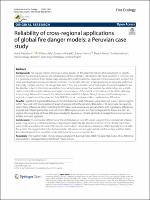| dc.contributor.author | Podschwit, Harry | |
| dc.contributor.author | Jolly, William | |
| dc.contributor.author | Alvarado, Ernesto | |
| dc.contributor.author | Verma, Satyam | |
| dc.contributor.author | Ponce, Blanca | |
| dc.contributor.author | Markos, Andrea | |
| dc.contributor.author | Aliaga Nestares, Vannia | |
| dc.contributor.author | Rodríguez Zimmermann, Diego | |
| dc.date.accessioned | 2022-12-01T16:46:18Z | |
| dc.date.available | 2022-12-01T16:46:18Z | |
| dc.date.issued | 2022-12 | |
| dc.identifier.issn | 19339747 | |
| dc.identifier.uri | https://hdl.handle.net/20.500.12542/2519 | |
| dc.description.abstract | Background: Fire danger indexes (FDIs) are used as proxies for fire potential and are often developed for specific locations. For practical purposes, the extrapolation of the underlying calculations into novel locations is common, but it is generally uncertain if the relationships between FDIs and fire potential observed in the environment in which the index was developed are equally relevant in others. For example, although a topographically, ecologically, and climatologically complex country, f ire danger forecasts in Peru use a standard set of nationwide thresholds applied to the Fire Weather Index. In this study, we validate the underlying assumption that weather-fire relationships are spatially uniform within Peru by (1) making cross-regional comparisons of the statistical distributions of four FDIs—Burning Index, Energy Release Component, Fire Weather Index, and Keetch-Byram Drought Index, and (2) making cross-regional comparisons of the expected daily MODIS hotspot count percentiles conditioned on FDI values. Results: Significant regional differences in the distributions of daily FDI values were observed in every pair of regions within Peru, and with the exception of a pair of regions within the Amazon, little data (< 90 days) were necessary to detect these differences. After controlling for FDI values and seasonal and annual effects with regressions, differences in predicted hotspot percentiles were common, differing by as much as 47 percentage points. Across the pairs of regions, the magnitude of these differences tended to decrease as climatic similarity increased, but some counterexamples were also apparent. Conclusions: The noticeable differences in the distributions of daily FDI values suggest that a standard set of breakpoints may produce unreliable inferences regarding fire potential. We also find that even if the climatic conditions were similar across Peru, the same FDI values in two locations can produce substantially differing predictions of wildfire activity. This suggests that other factors besides FDI values can strongly mediate wildfire activity and that better fire potential predictions could be produced if these factors are accounted for. | es_PE |
| dc.format | application/pdf | es_PE |
| dc.language.iso | spa | es_PE |
| dc.publisher | Springer | es_PE |
| dc.relation.uri | https://fireecology.springeropen.com/articles/10.1186/s42408-022-00150-7 | es_PE |
| dc.rights | info:eu-repo/semantics/openAccess | es_PE |
| dc.rights | Atribución-NoComercial-SinDerivadas 3.0 Estados Unidos de América | * |
| dc.rights.uri | http://creativecommons.org/licenses/by-nc-nd/3.0/us/ | * |
| dc.source | Repositorio Institucional - SENAMHI | es_PE |
| dc.source | Servicio Nacional de Meteorología e Hidrología del Perú | es_PE |
| dc.subject | Incendios Forestales | es_PE |
| dc.subject | Fire potentia | es_PE |
| dc.subject | Rainforest | es_PE |
| dc.title | Reliability of cross-regional applications of global fire danger models: a Peruvian case study | es_PE |
| dc.type | info:eu-repo/semantics/article | es_PE |
| dc.identifier.doi | https://doi.org/10.1186/s42408-022-00150-7 | |
| dc.identifier.journal | Fire Ecology | |
| dc.subject.ocde | https://purl.org/pe-repo/ocde/ford#1.05.09 | es_PE |
| dc.subject.ocde | https://purl.org/pe-repo/ocde/ford#4.01.02 | es_PE |
| dc.subject.sinia | superficie deforestada - Biodiversidad y Ecosistemas | |
| dc.type.sinia | text/publicacion cientifica | |
| dc.identifier.url | https://hdl.handle.net/20.500.12542/2519 | |









